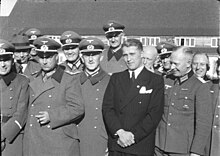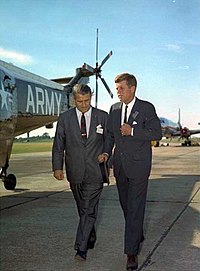Wernher von Braun
Wernher Magnus Maximilian Freiherr von Braun (Wirsitz, German Empire; March 23, 1912 – June 16, 1977, Alexandria, United States), known as Wernher von Braun, was a German mechanical and aerospace engineer, naturalized American in 1955 in order to be integrated into NASA. He is considered one of the most important rocket designers of the 20th century, and was the chief designer of the V-rocket. 2, as well as the Saturn V rocket, which took humans to the Moon.
Von Braun was a highly controversial character, who dedicated his life to the development of rockets for the conquest of space, even though he had to offer them as weapons for his development, which he hesitated to do, as he commented to his relatives in his last years. These statements can be seen in an interview by Ernst Stuhlinger for a documentary on Wernher von Braun.
Early Years
His father was Baron Magnus Maximilian von Braun, a German nobleman, and his mother was Baroness Emmy von Quirstorp. From an early age, Von Braun fell in love with the possibilities of space exploration through the novels of Jules Verne and H. G. Wells, and also through the scientific works of Hermann Oberth, whose classic study Die Rakete zu den Planetenräumen (Into Space in a Rocket) encouraged Von Braun to study calculus and trigonometry to understand the physics of rocketry.
The day of his confirmation in the Lutheran church, his mother, an astronomy fan, gave him a telescope. She quickly exhausted the capacity of the telescope and convinced some schoolmates to help her build an astronomical observatory with parts from an old car.
In the ranks of the SS
In his teenage years, von Braun, interested in space flight, joined the German rocket society Verein für Raumschiffahrt (VfR) in 1929. In 1932 he graduated in mechanical engineering at the Polytechnic Institute of Berlin, and two years later he obtained his PhD in Physics from the University of Berlin.
In his quest to develop large rockets, he enlisted in the German Army to develop ballistic missiles before Adolf Hitler came to power in 1933, and was later seconded to the SS in 1940. As his right-hand man (Ernst Stuhlinger) in an interview, Von Braun had a hard time accepting the offer to join the SS. While doing his work for the Army, von Braun earned a Ph.D. in aerospace engineering on July 27, 1934.
On October 3, 1942, the A2 was launched, the first modern rocket equipped with an automatic guidance mechanism. In a few minutes it moved to a distance of 190 km from the launch point,[citation needed] until it ran out of fuel, reaching a maximum height of 3.5 km.
World War II: V2 rockets
At the start of World War II, the German high command commissioned him to design a rocket loaded with explosives in order to attack enemy territory. Von Braun's engineering team worked in a secret laboratory in Peenemünde, on the Baltic coast, where he designed the A3 and A4 models. Hitler, enthused by the successes achieved, ordered the mass production of the A4 under the name "Vergeltungswaffe 2" (number 2 retaliatory weapon) or simply V2, intended to attack London and English soil. For the production of these weapons, Von Braun employed forced laborers, prisoners from concentration camps, and more slave laborers died in the factories, an estimated 20,000, than the people killed by the bombs themselves, Von Braun admitted having visited the Mittelwerk plant and was therefore fully aware of the facts; many slave laborers were also killed in a subsequent bombing raid on Peenemünde.
The first time a V2 missile was used for military purposes was in September 1944: Starting on September 8, 1944, German forces launched V2 missiles against Allied cities, especially Antwerp (Belgium) and London (United Kingdom). The main advantage of the V2 was that they hit without warning (flying at supersonic speed, they reached their target before the noise of their approach was heard), so there was no effective defense mechanism. As a result of this, the V2s were a factor of terror beyond their actual destructive capabilities, as the guidance system for these missiles was imperfect and therefore many failed to reach their target.
By the end of the war, 1,155 V-2 missiles had been fired at the UK, as well as another 1,625 missiles at Antwerp and other continental targets.
Operation Paperclip: move to the United States
Despite his collaboration with the German Army, Von Braun ran into trouble with the Gestapo by publicly confirming that he cared very little about Hitler's goal; the only thing that mattered to him was interplanetary travel. By early 1945 it was obvious that Germany would not win the war, so von Braun began planning his postwar future.
Von Braun was able to contact the Allies and prepared his surrender to the US forces, who were carrying out Operation Paperclip to capture German scientists and put them at the service of the Allied side. Von Braun turned himself in along with 500 other scientists from his team, their designs and several test vehicles. He was about to be captured by the Soviets, who wanted to integrate him into Sergei Korolev's team.[quote required]
Once in the United States, von Braun and his associates were urged to cooperate with the US Air Force, and in exchange, they would be absolved of their Nazi past; this included deaths caused by the use of their air projects by the Nazis and by using slave laborers. Von Braun obtained United States citizenship on April 14, 1955. He had married Maria von Quirstorp on March 1, 1947, with whom he had two daughters, Iris and Magrit, and a son, Peter.
For the next five years, von Braun and his team were stationed at Fort Bliss, Texas, where he worked for the United States Army developing ballistic missile launchers at the White Sands, New York, proving ground. Mexico).
I work at NASA
The V2 rocket was the forerunner of space rockets used by the United States and the Soviet Union. In 1950, von Braun's team moved to the Redstone arsenal near Huntsville, Alabama, where they built the Jupiter ballistic missile for the military and the Redstone rockets used by NASA for the early launches of the Mercury program. In 1960, its center for the development of rockets was transferred from the army to NASA and there they were entrusted with the construction of the gigantic Saturn rockets, the largest of which was the one that put man on the Moon. Von Braun became the director of NASA's Marshall Space Flight Center and the lead designer of the Saturn V, which during the years of 1969 and 1972 would take Americans to the Moon.
By the 1950s, von Braun was already well known in the United States, acting as the spokesperson for that country's space exploration. In 1952 he gained more publicity thanks to his articles on space subjects published in Collier , a weekly magazine of great importance in those days. His name also became a daily part through his participation in three Disney television programs dedicated to space exploration. The American feat of putting a man on the moon turned off those who still attacked von Braun for using slave laborers during the Nazi period.[citation needed]
Engineering Philosophy
Von Braun's insistence on further testing after the Mercury Redstone 2 spacecraft flew higher than expected has been identified as a contributing factor to the Soviet Union's success in launching the first human into space. The Mercury Redstone BD flight was successful, but it took up the launch slot that could have put Alan Shepard into space three weeks before Yuri Gagarin. His Soviet counterpart Sergei Korolev insisted on two successful dog flights before risking Gagarin's life in a crewed attempt. The second test flight took place one day after the Mercury Redstone BD mission.
Von Braun took a very conservative engineering approach, designing with large factors of safety and redundant structures. This became a point of contention with other engineers, who were struggling to keep the weight of the vehicle low in order to maximize payload. His excessive caution probably led to the United States losing the race to put a man in space before the Soviets. Krafft Ehricke compared von Braun's approach to the construction of the Brooklyn Bridge. Many at NASA headquarters jokingly referred to the Marshall Space Flight Center as the "Chicago Bridge & Iron Company", but they recognized that the designs worked. The conservative approach paid off when a fifth engine was added to the Saturn C-4, producing the Saturn V. The C-4 design had a large crossmember that could absorb easily the thrust of an additional engine.
Another point of contention was with Abe Silverstein, also an engineer and NASA program manager, who developed liquid hydrogen propulsion. Von Braun, whose doctoral thesis in space engineering (presented in Berlin in 1934) dealt precisely with rocket propellants, he planned to make use of kerosene or alcohol fuel in all phases of the Saturn V's flight. Silverstein, on the other hand, suggested that the properties of liquid hydrogen would be optimal for the second and third phases. of the flight, although von Braun calculated that they would provoke an explosive reaction. This generated a marked tension around the development plans of the program, culminating in a meeting in 1959 that ended in a disagreement. Von Braun's calculations, without However, they turned out to be wrong, and in 1967, after the successful phase of tests of the engines, he dedicated the success of the results to Silverstein.
Withdrawal
He was asked by NASA in 1970 to move to Washington, D.C. to lead the agency's strategic plan. Although he left his home in Huntsville, Alabama, he only worked for NASA for another two years, later going to work for Fairchild Industries in Germantown, Maryland. Affected by pancreatic cancer, he retired from Fairchild on December 31, 1976. Six months later he would die.
Death
In 1973, von Braun was diagnosed with kidney cancer during a routine medical exam. However, he continued to work without restrictions for several years.
In January 1977, already very ill, he resigned from Fairchild Industries. Later in 1977, President Gerald Ford awarded him the country's highest scientific honor, the National Medal of Science in Engineering. However, he was too ill to attend the White House ceremony.
Von Braun died on June 16, 1977 of pancreatic cancer in Alexandria, Virginia, at the age of 65. He is buried on Valley Road in the Ivy Hill Cemetery. His tombstone quotes Psalm 19: 1 of the Bible & # 34; The heavens declare the glory of God, and the firmament shows the work of his hands & # 34; (KJV).
Eponymy
- Moon crater Von Braun carries this name in his memory.
Contenido relacionado
(29) Amphitrite
STS-61-B
Right ascension




